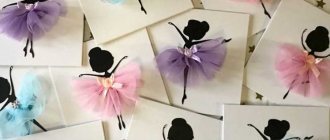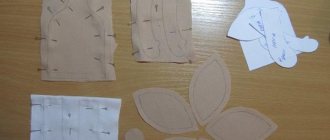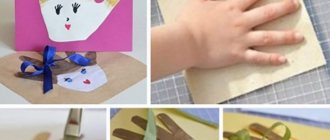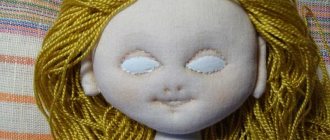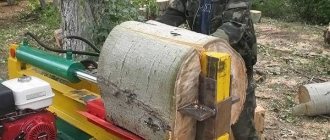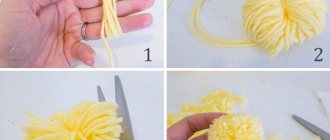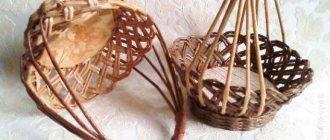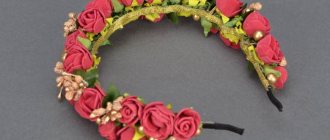In ancient times, the Slavs had a tradition of making amulets from fabric. Every family made a lot of them for all occasions. One of the most popular was the herbalist doll. It was not only a talisman protecting against misfortunes and evil spirits. It also contained elements of healing. Medicinal herbs that filled the pupa prevented illness, improved sleep, and drove away infections. And it’s not difficult to make such a talisman, you just need to choose the right materials and follow traditions.
The history of the amulet
In ancient times, the Slavs had dolls-amulets in every home. They protected the house from evil people and evil spirits, and served as personal talismans. Each had its own meaning. The herbalist was also called the Kubishka, since its filling was also sacred. If magical herbs were used to ward off evil forces, such a doll would purify the air in the house, ward off illnesses and misfortunes, and create a favorable atmosphere.
But most often the herbalist was filled with fragrant medicinal herbs. Such a doll was placed at the head of the bed and given to children to play with. When crushed, it gave off a pleasant aroma. It protected a person from infections, calmed or invigorated, and helped to stay healthy. These amulets were made from scraps of clothing. In the 20th century, rag dolls almost disappeared; people stopped believing in their power. But the tradition of making it has remained; some people still protect their home and family members with the help of such amulets.
The herbal pot is the most popular Slavic amulet.
Types of Motanok dolls and their meaning
To figure out when you need a talisman, you need to study the features of these figures. Only women made them while the men were away from home.
By how successful the doll turned out, they judged the girl’s readiness for marriage.
Rag reels are divided into 3 types:
- Gaming. Simple fun for kids without a magical component.
- Ritual. They sewed on Maslenitsa and Ivan Kupala to appease the gods.
- Amulets. They were created to protect the family.
Herbalist-pot
One of the most common pupae, the fabric was stuffed with dried medicinal plants. Such figurines were placed in the beds of the sick, and when they recovered, the coils were burned in the yard.
Herbalist-little doll with grass.
Zolnaya
Scientists consider her to be the very first doll-amulet, protecting the hearth. The ash was rolled into a ball and placed in the doll's head. She differed from others in the absence of a headscarf and hair; she was passed down from mother to daughter as protection for her ancestors.
plantain
In past centuries, journeys lasted for months. For protection on the way, women sewed special dolls for their husbands - Plantains. A bag containing a handful of native soil was placed in the doll’s hands to give her strength. They also added grain or crackers so that the traveler would always be well-fed.
Pelenashka
Such reels were sewn by women who learned about pregnancy, resulting in a tiny baby in diapers. These products were hung on the windows shortly before childbirth to protect the expectant mother from the evil eye. When the baby appeared, the doll was placed in the cradle.
Diapers for pregnant women.
Lovebirds
This amulet consists of 2 connected dolls: a man and a woman. It is customary to give them as a wedding gift so that the newlyweds are lucky and happy. The toy is based on a branched stick; the fabric is wound around the branches. You need to store it above the head of the bed, then the couple will live well and amicably.
Day Night
This talisman is different in that it is 2-sided. One figurine is made light, the second - dark, then tied back to back. Or they sew 1 motanka with 2 faces on different sides. The task of the Day-Night doll was to protect the family from evil spirits and unkind people during the day, and at night the doll protected the dreams of its charges from evil spirits.
Bride
Dolls in a wedding dress were given to girls on their wedding day; their mothers or sisters sewed them. There was a belief that this amulet would protect the young woman from the evil eye, envy and damage in the first year of family life.
Doll for the bride from the evil eye.
Desire
Such a reel was made for a dream; it could make any wish come true, but only one. There is also a condition: you can ask for a doll only once in your life. When making it, you need to constantly think about what you want, then repeat it out loud three times in front of the mirror with a magic toy in your hands.
Secrets of creating the Desire:
- Sew a bead onto the doll's dress or tie a ribbon on the handle.
- A motanka helps only the one who made it, with the exception of a wife’s request for her husband.
- You need to use only new fabrics; you cannot bargain when purchasing.
- When the wish comes true, the magical figurine must be destroyed.
Desire for dreams.
Purifier
Such a doll is sewn for recovery; it is believed that it absorbs bad energy and prevents illness from draining strength. The doll was placed near the person, and when he felt a little better, the amulet was burned in the yard.
Ten-handle
A magical toy with 10 arms is given to a young wife on the second day of the wedding so that she has time to manage all her affairs. If there was a lot of trouble, the owner had to ask the doll for help.
Princess
Girls sew such a motanka to attract suitors. They make the amulet beautiful, elegant, decorate it with ribbons and beads; the more elegant the outfit, the richer the beneficiary will be. Married women were also allowed to make dolls to prevent their spouses from looking at others.
Beautiful doll Princess.
Fertility
This doll is a talisman for the family; it ensures that the family has healthy children and peace and love reign. It is made up of several figures: parents and children. Such a magical toy should not be given into the hands of strangers.
Bereginya
Represents goodness, protects the family hearth, takes care of health, prosperity and mutual understanding in the home. The motanka is distinguished by a pouch in the hands; grain, medicinal herbs or coins are placed there.
Bereginya to protect your home.
Well-being
Promotes prosperity at home and brings joy. Looks after the children and is friends with the brownie. It is customary to give a doll as a gift for the New Year; during production, coins are sewn into the fabric.
Brownie
This amulet is made to protect against evil people, fires, thieves, and witchcraft. They put any prayer written with their own hands into the head of the motanka. Attached above the front door or window.
Cabbage
This name was chosen because cabbage is considered a symbol of female maturity and fertility. This doll was responsible for a successful marriage. If it was put out the window, it meant that matchmakers could be sent. The bride took the amulet to her new family and placed her first-born child in the cradle along with a diaper.
Lyalka cabbage for marriage.
Easter
This reel was made for the biggest church holiday. The doll, which personified the Mother of God, was given a pysanka and a willow branch.
bbw and pregnant
If a couple did not have children for a long time, healers advised women to sew a special motanka. It was made by the relatives of the young mistress; it had to be done with great love and wishes for happiness.
Then the owner sat the plump baby doll in a prominent place and invited guests to admire it. When pregnancy occurred, the amulet was hidden until childbirth, then given to children to play with.
While the baby was expected, another doll guarded the expectant mother; she was made with a protruding belly. They kept it in a visible place until the baby appeared, and then put it away from prying eyes.
Amulet for a pregnant woman.
Veduchka
This amulet consists of 2 figures: a mother and a child, whom she guides through life. Their handles are made from an unbreakable piece of fabric, as a sign of eternal connection. They are made to protect children from damage, and they give dolls to mothers-in-law and daughters-in-law so that they will be good wives.
Krupenichka and the rich man
They made such a talisman to ensure a generous table in the house. The motanka was filled with wheat or cereals, according to tradition, from the new harvest, and they asked for prosperity for the whole year. She was paired with the “Rich Man” amulet; he helped Krupenichka with advice, protected her property and increased her earnings.
Successful
This doll was made for good luck in business. Such a reel should have a bag on its shoulder in which the bill is placed. For the amulet to work, you need to explain in detail to the doll what is expected of her.
Doll-amulet for success in all endeavors.
Spiridon solstice
It belongs to the ritual motankas; it was given a special role during the summer and winter solstice holidays. The doll was dressed in men's clothing, named Spiridon, and a wheel with 8 spokes was placed in its hands.
The ancestors believed that by turning it, you could change your destiny, so such a doll was given as a gift to attract good changes. When everything was done, the figurine was burned at the stake.
Spiridon solstice to perform the ritual.
The meaning of the herbalist doll
Each amulet has its own meaning. The herbal pot is designed to protect and improve health. She has the following abilities:
- strengthens the immune system, protects against colds, helps to recover faster;
- calms, relieves stress, eliminates depression and normalizes sleep;
- restores strength;
- protects the house from conflicts, evil people, troubles;
- attracts luck, wealth and love.
Depending on the purpose for which this amulet doll is made, it is filled with different herbs. There are several varieties of Eggs: for health, protecting the home, attracting good luck. Previously, they made many such dolls for all occasions. They were hung at the head of the bed, given to the child, placed in the kitchen, in the pantry, in each room, near the entrance.
This doll protects adults and children from diseases
For good health
Most often, the Herbalist was used to improve health and protect against diseases. This can be explained by the fact that herbs rich in essential oils were used. And the benefits of aromatherapy are now recognized even by official medicine. Such amulets help strengthen the immune system, protect against colds, and soothe. They are placed near the pillow, in the crib. Depending on what herbs fill the doll, its properties change:
- thyme, hops, mint, lavender - help with insomnia, calm;
- chamomile, wormwood, yarrow, St. John's wort, pine needles, currant leaves - strengthen the immune system, protect against infections;
- mint or lavender relieves headaches;
- thyme, oregano - help with cough;
- wormwood, dandelion - improve appetite.
To protect your home
The herbal pot is often used as a home amulet. It is placed in a corner or hung above the entrance. It will not only protect you from negativity, troubles or bad thoughts, but will also purify the air at home. In order for the doll to become a protector, it must be filled with the following herbs:
- St. John's wort;
- nettle;
- sunflowers;
- asters;
- marigold;
- sagebrush;
- carnation.
A herbalist can also be made to attract good luck, love, and prosperity. To do this, it is filled with jasmine, lilies of the valley, chamomile, bird cherry, lavender, and fern. You can put a coin or a bean inside, and decorate the doll with ribbons, beads, and embroidery.
By choosing the right herbs, you can use an herbalist to protect your home
External magical features
Making such a doll is not difficult, but in order for it to have magical powers, you need to pay attention to detail.
Breast
Such dolls always had large breasts. Among the Slavs it was a symbol of prosperity, health, and fertility. The larger it is, the greater the wealth in the house. When making a herbalist, you need to ensure that the breasts are even and of the same size. To do this, you can fill it not with herbs, but with cotton wool.
Headdress
Be sure to make a traditional women's headdress. This headband is a strip of fabric or ribbon with a scarf on top.
Apron
The apron symbolizes the housewife; it collects positive energy to protect the home and all family members. It is recommended to make the apron long; the longer it is, the more children there are in the family. For an apron, you can take several different scraps of lace. If there are stripes on the fabric, they should be horizontal.
All details of this amulet have their own magical meaning
Weaving dolls
Three-dimensional figures have long been made by parents for their children. In addition to its direct purpose as a toy, the doll was also endowed with the properties of a talisman or medicine. So, when weaving straw, fragrant herbs were added to treat coughs or other misfortunes.
According to the tradition of the Eastern Slavs, such a doll did not have facial features depicted. According to beliefs, an evil spirit can move into a figurine with a face, and if it does not, then the doll was considered an inanimate object, so spirits will not linger there.
There was a tradition before the wedding to make large figures of the bride and groom and place them at the gate at the entrance to the courtyard. Since straw symbolized fertility, the dolls were supposed to contribute to the appearance of offspring in the family.
Making a doll of a herbalist with your own hands
All Slavic dolls are made according to the same rules: use only natural materials, do not use scissors and needles, tie parts with red thread. And the basic principle is that such a talisman should not have a face.
All elements of the doll have magical meaning. It is important to choose the right materials and filling. It is advisable to cut the shreds all at once; if the amulet is to be decorated with embroidery, this is also done in advance. Do not use scissors or needles during assembly. And one more rule - women should be engaged in making amulets dolls.
Tools and materials
Such dolls are made without sewing, they are rewound with threads, which is why they are also called motankas. The main tools for making a herbalist are natural threads, preferably red. For stuffing, prepare herbs, roots, seeds, wood shavings. The doll's chest and head can be filled with cotton wool, scraps or threads. It is undesirable to use padding polyester or foam rubber; it is believed to have negative energy.
The fabric for the doll should be bright, light shades. It should not contain gloomy, dark colors. It is recommended to take pieces of the amulet owner's favorite clothes. The fabric should be natural - cotton or linen. Before making a herbalist doll, you need to prepare the following scraps:
- for the face, a piece of approximately 20X20 cm, it should be white or light pink;
- for the chest and pouches - two multi-colored shreds measuring 15X15 cm;
- 2 pieces 30X30 cm of any color for hands;
- 2 pieces of 40X40 cm - one white, the other colored - this will be the body of the doll, filled with herbs;
- triangle for scarf approximately 25X25X35 cm;
- a piece of fabric for an apron, ribbons for a headband, a belt and other decorations.
All materials for the doll must be prepared in advance.
Manufacturing stages
The technique for making such dolls is winding and tying with threads. It is necessary to prepare all the scraps and decorations in advance, and you need to assemble the herbalist at one time, without leaving it unfinished for later. Making an herbalist is not difficult, especially if you use a step-by-step guide for the first time.
- First make the head and two pouches for the chest. Tie them with red thread, wrapping it an odd number of times. And there must be an even number of knots. Do not cut the ends of the thread. The chest should be smaller than the head.
- Take pieces of fabric intended for hands. Fold them into triangles several times. Then cross these parts, put the head on them, then the chest, and tie everything with thread. After this, start making the body - a bag of herbs.
- The body is first made of white fabric. They tie it to the doll's belt. After this, cover the body with a colorful piece of paper. It needs to be tied, hiding the edges and any protruding pieces of fabric.
- After this, the doll needs to be decorated. They tie an apron to her, put on a warrior, and a scarf on top. Two bags of herbs are tied to the handles.
Head decoration
We tie a thin strip of fabric to the forehead. This will be a warrior.
We use the triangle as a scarf, pull it tightly over the head and tie it at the back.
To give our doll a complete look, we attach (also tie) two rectangles of fabric. This will be the apron.
For beauty, the doll's apron is two-layered, although it can be multi-layered.
To make the apron original, the edges of the blanks were loosened to create a fringe.
The doll is ready to protect the family.
You can make such a souvenir yourself and give it to close relatives.
How to charge and activate the amulet
Making such amulets is a kind of ritual. The properties of the doll strongly depend on the mood in which the master works. You need to think about the good, tune in to the positive. The craftswoman should be surrounded by a calm environment; you can light candles. Mentally say wishes for health and good luck. You can use ready-made folk conspiracies or do it in your own words.
After making the amulet you need to charge it. To do this, it is best to leave the doll in the sun for several hours. Then talk to her, ask for help and protection, and thank her for it.
You need to charge the amulet with a positive attitude and good thoughts.
Methods and rules for using a doll
A properly made amulet brings only benefits. But there are features of application, on which its properties also depend. There are several ways to use an herbalist:
- at the head of the bed, the doll drives away bad dreams and helps with insomnia;
- above the child’s crib brings him health, wards off damage;
- protects from bad energy and conflicts anywhere in the house;
- near the entrance protects from evil people, thieves;
- in the kitchen it prevents the appearance of pests, increases appetite, and disinfects the air.
The amulet is placed in a visible place, but preferably high so that it is not touched. From time to time it needs to be gently crushed to activate the essential oils. After 2 years you will need to change the herbs.
The herbalist is the most popular amulet and protection against disease in the past. Now you can also take advantage of its beneficial properties. The aromas of herbs that this doll emits will create a peaceful atmosphere in the house, help you calm down and protect you from diseases.

